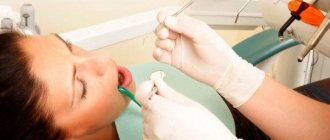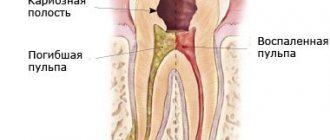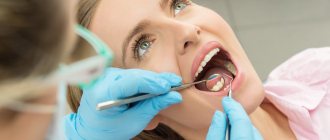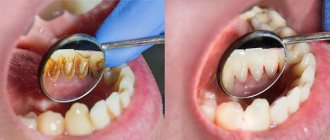Author of the article:
Soldatova Lyudmila Nikolaevna
Candidate of Medical Sciences, Professor of the Department of Clinical Dentistry of the St. Petersburg Medical and Social Institute, Chief Physician of the Alfa-Dent Dental Clinic, St. Petersburg
Expecting relief from pain from going to the dentist, patients sometimes leave the office confused - why hasn’t the pain completely gone away? It can be present for several hours or last much longer.
Why does a tooth hurt after filling?
The filling that the doctor places on the treated tooth should exclude the possibility of disease. If you feel pain after filling, the reason may be:
- The body's natural reaction to outside interference. Even after proper treatment, such a phenomenon may occur, which is periodic in nature. The pain in this case does not increase or become too severe; it can last from 2 weeks to 2 months.
- Caries is not completely cured. The tooth tissues become inflamed, and the tooth hurts after filling with aching pain. In this case, it is necessary to contact the dentist again to prevent further complications - inflammation can affect the dental nerve (pulpitis develops).
- Chronic or developing pulpitis that was not identified during the diagnostic process before the start of treatment.
- Incomplete treatment of tissues affected by inflammation during periodontitis. Treatment of periodontitis is not limited to one day, it is quite complex.
- If the filling is installed incorrectly (either at an insufficient level, or is large and puts pressure on other teeth or gums). Often a tooth hurts after root canal filling for this very reason. Damage to the filling can occur due to insufficiently high quality filling material or failure to comply with the recommendations of the dentist.
- Slight pain may be felt due to tissue injury during the process of tooth filling. It will take some time for healing to occur.
- The sensitivity of teeth after filling always increases significantly, and discomfort, manifested in painful sensations, can be the result of insufficiently correct implementation of one of the treatment procedures - drying the inner dental walls (over-drying or under-drying). If the walls of the tooth are not completely dry when installing the filling, it does not adhere well in damp places, which leads to the development of inflammation and pain.
- Allergic reaction to the filling material.
It is much easier to identify pathologies after dental treatment if all the dentist’s advice and oral hygiene rules are followed.
Attention! Dentists recommend that their patients have a small snack before going to the dental office, so that due to the lack of glucose that occurs during treatment, fear and the vasoconstrictive effect of the drugs, they do not experience a semi-fainting state during the treatment.
How long after filling should I abstain from eating?
Modern fillings contain epoxy resin, which ensures that the new filling quickly hardens into the desired shape. Light-polymer fillings harden almost instantly, while those made from chemical materials take no more than an hour. Therefore, after filling a tooth, you can eat food immediately.
When installing a temporary filling, a longer period of time abstaining from eating is required - at least 2 hours.
Why gums become inflamed after treatment: possible reasons
Minor inflammation after dental canal filling or other types of treatment is considered normal and does not require special therapy except for maintaining a hygienic regime. But if the inflammation does not go away on the second or third day, and is accompanied by severe pain, hyperemia of the mucous membranes, and swelling, the cause should be found out. It is not recommended to use anti-inflammatory and antibacterial drugs without consulting a dentist - self-medication can aggravate the problem and lead to progression of the pathology.
Allergic reaction
One of the most common causes of inflammation of the gum tissue is an allergy to medications used for local anesthesia. In this case, inflammation is manifested by severe local swelling at the injection site, redness and soreness of the tissue. An allergic reaction can also occur to the following groups of drugs used during dental procedures:
- hemostatics (hemostatic drugs, used mainly after extraction of a tooth from a bone alveolus);
- antibacterial drugs (placed in the tooth cavity when there are signs of an infectious process);
- antiseptics, which are used to disinfect dental canals;
- disinfectant solutions for sterilization of medical instruments;
- arsenic paste for killing the dental nerve (rarely used in modern dental practice).
Inflammation of the gums can occur as a result of an allergic reaction
In addition to swelling and redness, rashes in the form of small pale pink dots may appear on the mucous membranes of the gums, accompanied by itching and burning.
Allergy treatment involves the use of drugs from the group of histamine receptor blockers. Popular antihistamines, as well as their regimen, are listed in the table below.
| A drug | Image | Reception scheme | Cost (average values are indicated for packaging with a minimum volume) |
| "Claritin" | 10 mg 1 time per day, regardless of meals | 155 rubles | |
| "Loratadine" | 10 mg 1 time per day | 12 rubles | |
| "Erius" | 5 mg once a day at the same time | 224 rubles | |
| "Fenistil" | 20 drops in the morning during breakfast and 40 drops in the evening before bed | 356 rubles | |
| "Zodak" | 10 mg 1 time per day | 122 rubles | |
| "Tavegil" | 1 mg 2 times a day before meals | 145 rubles |
Important! All dosages in the table are indicated for adult patients and adolescents over 12 years of age. The regimen for use in childhood is selected individually.
Poor quality treatment
Errors during dental treatment can also lead to inflammation on the first or second day after the manipulations. The most common cause of such symptoms is infection of soft tissues as a result of pathogenic bacteria, fungi or viruses entering the damaged gum. To avoid this, you must follow all the dentist’s recommendations, especially in the first 72 hours after treatment. To prevent complications, which include inflammatory processes in the gums, the patient is recommended to:
- do not eat or drink for 2-8 hours after treatment (the final time depends on the type of therapy performed, the severity of the underlying diagnosis and the medications used);
- rinse your mouth with antiseptics or anti-inflammatory decoctions of chamomile, calendula or St. John's wort (on the first day it is better to do oral baths);
- take antimicrobial and antibacterial drugs if prescribed by a doctor;
- maintain a gentle hygiene regime so as not to injure your gums.
Poor treatment can cause gum inflammation
Important! In especially severe cases, inflammation can be triggered by a foreign body. This situation is possible when the special needles that are used to clean the canals break off. Symptoms of this pathology will be manifested by severe pain, swelling and swelling of the gums, severe hyperemia of the mucous membranes around the filled tooth. If such signs occur, you should immediately consult a doctor (if pain and inflammation appear at night, you can contact the emergency dentist).
Tooth injury during treatment
Damage to soft or hard tissue that may occur during the use of medical instruments can lead to the formation of cysts. Cysts are growths in the form of cavity sacs that have an oblong and elongated shape and are filled with exudative or purulent fluid. If the cyst is not treated in time, it can develop into a granuloma - a benign tumor of the dental root (located mainly at the apex of the root system).
Advanced dental cyst
Cysts can go undetected for a long time. They are characterized by a slow course with mildly expressed symptoms. During the formation of a cyst, the gums may look inflamed and hyperemic, but after a few days these signs disappear, and the person mistakenly thinks that everything is fine.
- How long does it take for drugs to leave the body?
Important! If there are frequent inflammatory processes in the gums around the tooth that has been treated, it is necessary to consult a doctor and undergo an X-ray examination to exclude formations of various etiologies.
Video: Why gums become inflamed
My gums hurt after filling a tooth, what should I do?
If, after installing a filling, your gums are very sore and even your cheek is swollen, you cannot do without the help of a dentist. Moreover, it is necessary to contact as soon as possible so that there are no even more unpleasant consequences.
A few tips to relieve pain:
- applying an ice compress to the cheek at the sore spot for several minutes or a compress with ice cubes;
- alternate application of compresses with warm rinses from decoctions of medicinal herbs or infusions;
- painkillers;
- balms to strengthen teeth and gums.
Attention! Under no circumstances should you apply hot or warm compresses - they actively provoke inflammation and pain!
Taking antibiotics without a doctor's prescription is also extremely contraindicated, because this can lead to a decrease in immunity and complicate further treatment.
Preventive measures
After filling a tooth, during the first week, you must strictly follow the main rules so that pain does not occur, or it disappears as soon as possible:
- do not drink or eat too cold or too hot, as temperature changes provoke pain;
- every time after eating, brush your teeth and rinse your mouth with special anesthetic rinses (the ASEPTA series includes rinses with an analgesic and disinfecting effect);
- try to eat softer foods so as not to damage the periodontal tissues, and it is preferable to chew only on the healthy side;
- do not smoke, as the tooth disturbed by treatment is very sensitive in the first days.
What causes long-term pain after tooth extraction?
Long-term (more than a week) pain occurs due to one of the following complications:
1. Alveolitis
If the gum does not heal under the blood clot and the tooth socket becomes inflamed, then the tissue adjacent to the gum begins to rot.
Signs:
- increasing aching pain, turning into a sharp “shooting”;
- gum swelling;
- temperature increase;
- smells like rotten breath.
Untimely relief of alveolitis leads to necrosis of gingival and alveolar tissue. Several teeth may need to be removed.
How is it treated?
The well is washed with an antiseptic, cleaned of existing foreign particles and washed again. Then a lotion with an antiseptic and anesthetic is applied.
2. Cyst
A “sac” on the gum in which fluid or pus accumulates.
Symptoms:
- discomfort and pain when biting;
- feeling of heaviness and foreign body in the area of the extracted tooth;
- development of sinusitis;
- general malaise, lethargy, fever up to 37.5°.
If left untreated, the cyst leads to the destruction of gum tissue and loss of teeth located next to it.
What to do?
At the initial stage, it is enough to take a course of antibiotics, and the cyst will “resolve.” If pus has formed in the “bag”, surgical opening of the cyst cannot be avoided.
3. Flux
When pathogenic bacteria enter the periosteum, periostitis occurs.
Symptoms:
- gum swelling;
- swelling of the cheek;
- formation of a purulent abscess;
- severe, throbbing pain;
- heat.
Untreated periostitis turns into sepsis - infection enters the circulatory system. The result is death. This is why it is important to immediately seek help from a dentist.
What needs to be done?
The doctor will open the purulent formation, disinfect it and prescribe antibiotics to stop the inflammatory process.
Experts' opinion
The effectiveness of the ASEPTA series products has been proven by multiple clinical trials conducted in the country's leading research institutes.
For example, a study of the clinical effectiveness of treatment and prophylactic agents from the Asepta line in the treatment of inflammatory periodontal diseases, conducted by A.I. Grudyanov, I.Yu. Alexandrovskaya, V.Yu. Korzunina in the Department of Periodontology of the Central Research Institute of Dentistry and Maxillofacial Surgery of Rosmedtekhnologii, Moscow, made it possible to identify the fairly high effectiveness of the Asepta gum balm and the Asepta mouth rinse for moderate periodontitis. The use of Asepta mouth rinse for inflammation also turned out to be quite effective. In addition, no phenomena of mucosal irritation or brown staining of fillings were recorded. This indicates that the use of this rinse for a two-week period provides an obvious clinical effect in the absence of negative side effects.
How to speed up the healing process of the hole?
The process of tissue regeneration will be as comfortable and painless as possible if you follow the following instructions:
- do not injure the blood clot;
- do not eat for 3-6 hours after tooth extraction;
- exclude hard, spicy, sweet and hot foods from the diet for several days;
- avoid physical exertion, hypothermia and overheating for 3 days after removal;
- use a toothbrush with softer bristles;
- give up smoking and alcohol for a couple of days;
- Follow your dentist’s recommendations for taking anti-inflammatory and pain medications.
Consumer Reviews
Mrs. Doubtfire about Asepta Active mouth rinse (irecommend.ru):
“When I was faced with a serious gum problem, this rinse was recommended to me by a dental surgeon.
Asepta Active mouthwash is a medical product and is sold only through the pharmacy chain. The instructions recommend taking breaks in use. Personally, I use it in courses and during exacerbations of gum inflammation. I've been using it for about 2 years.
The mouthwash is minty, pleasant, slightly astringent. Improvement is felt from the first use. Bottle volume 150 ml. Manufacturer: Russia, St. Petersburg. A convenient measuring cup is included.
You can (better) buy it as a set, which also includes balm and toothpaste, which comes as a gift.
I’m very happy that such products from a domestic manufacturer have appeared!”
julia-06 about Asepta Active mouth rinse (irecommend.ru):
“A very good rinse for problem gums.
She had never encountered the problem of bleeding gums, but at her next visit to the dentist she noticed that when she only lightly touched her gums, they began to bleed. So the dentist gave me a mini version of Paradontax toothpaste and advised me to use a mouthwash after brushing my teeth. Mom bought Asepta active mouth rinse.
For some reason I used to be very skeptical about such remedies, but as it turned out, in practice it helps very well. My problem went away completely, my gums stopped bleeding. I don’t even want to read the ingredients and go into its details, it’s unlikely that everything is super natural, but since it helps, I give the mouthwash a solid 5 points. Of course, each case is individual, but I will recommend it based on my experience. And the price of the rinse aid is quite reasonable.”











